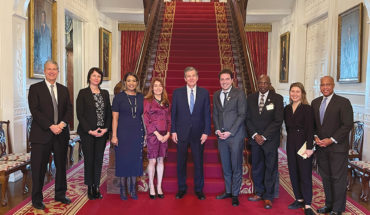As I conducted a recent art romp around the Triangle, I was dazzled by the superlative exhibitions being presented all at the same time. Why go to New York or Washington for the big museum shows when we have such riches right here? Miró: The Experience of Seeing is showing at the Nasher Museum of Art at Duke until February. Small Treasures: Rembrandt, Vermeer, Hals, and their Contemporaries is at the North Carolina Museum of Art until early January and Limited Visibility: Contemporary Art from Latin America is at CAM Raleigh until early January.
When I dropped in on the opening reception for Limited Visibility, it was ostensibly for a slug of white wine and to visit with Patti Garcia-Velez Hanna, the guest curator from Miami and the sister of my great friend, collector Carlos Garcia-Velez. I also wanted to chat with Hedy Fischer and Randy Shull, whose fine collection of Latin American art formed the basis of the exhibition. I forgot all about the wine when I began to experience the provocative and beautiful work in the show.
The suspended installation of handmade, clear glass bells by Brazilian artist Laura Belém is a knockout. The clappers are missing, however, which is the point of the show: omission, concealment, erasure. Let me say that this is not a show for lazy, stupid people. The viewer is called upon to look and think about the meaning of that which is taken away. Political and social environments and the metamorphosis of materials are obvious subjects explored by the artists. The drywall torn from CAM and the North Carolina Museum of Art and reconstituted as a “painting” by Pablo Rasgado and sandpaper work by Jennifer Allora and Guillermo Calzadilla are arresting and quite beautiful. There is video, photography, drawing, and every kind of medium and material used by artists today. More than 15 extraordinary artists are represented in the exhibition.
This is a show that could hold its own in major galleries and museums in New York or anywhere. We are fortunate that CAM Raleigh continues to bring us into a rich conversation about critical issues of our time.
Miró. This is not a typical university museum show, not that the Nasher is a typical university museum. This is an important exhibition of important work from the last 20 years of the artist’s life. Major paintings, including Woman, Bird and Star (Homage to Picasso) and Femmes III are showcases for the lyrical, colorful forms and symbols one associates with Joan Miró’s masterworks. There are many more.
Miró’s late sculptures are among his most inventive, expressive works. I was wowed by them. Assemblages of everyday objects cast in bronze are powerful and humorous. Rarely does one have the opportunity to see so many in one place.
Also at the Nasher is Rauschenberg: Collecting & Connecting, an exhibition of 34 works of art from the personal collection of Robert Rauschenberg. These rare, provocative objects offer insight into the mind of one of the greatest artists of the 20th century. We are fortunate the Nasher is bringing these iconic 20th-century works of art into our lives. The Mirós are from the collection of the Reina Sofía museum in Madrid and will be shown later in Denver and San Antonio.
Vermeer, Rembrandt again, Frans Hals, and scores of lesser-known but outstanding Dutch and Flemish masters from the 17th century are residing at the North Carolina Museum of Art until early January. These paintings are small, no larger than 8×10 inches, but oh so fine. Intricate works on copper, panel, and canvas attest to the absolute mastery of painting at the hands of Dutch and Flemish artists of the Golden Age. But you have to look closely and long.
My favorites in the show are, of course, the two Vermeer paintings, particularly Girl with the Red Hat. Keep in mind there are only about three dozen Vermeers in existence, and most are rarely lent. The portrait of an old man by Rembrandt is exquisite. Only recently authenticated, this masterwork joins the high moments of the artist’s early career. A Portrait of a Rabbi by Rembrandt, likewise, is considered the finest in the series of paintings he did on this subject. The group of Frans Hals works is a rare opportunity not to be missed, as are the orgiastic The Apulian Shepherd by Joachim Wtewael and the intimate portrait of The Young Artists by Caspar Netscher.
Limited Visibility, The Experience of Seeing, and Small Treasures, as the titles indicate, insist that we look. They require close attention and ample time to savor. The convergence of such rich visual experiences comes rarely. It is important that we all jump in.






